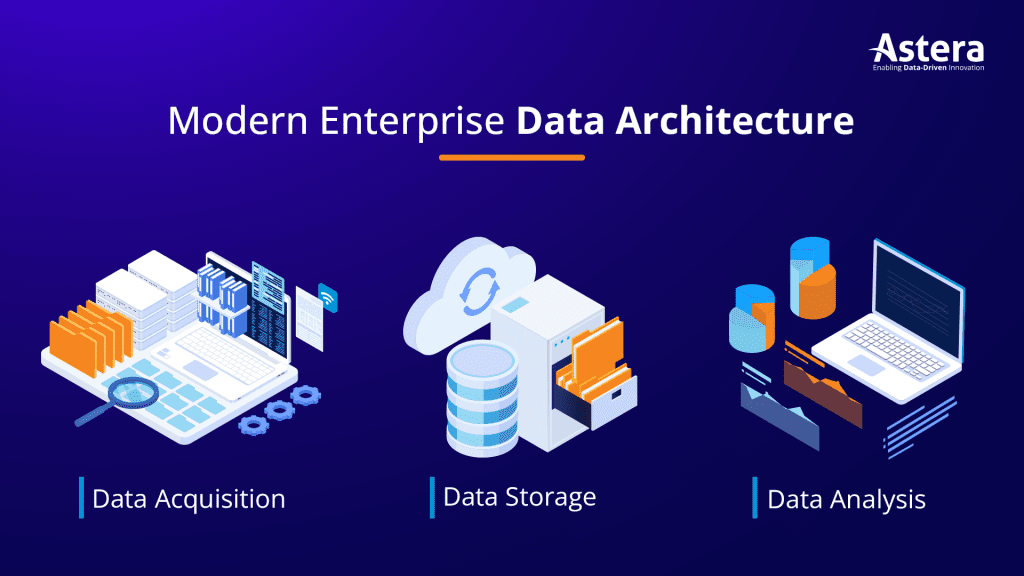Given the rapidly changing nature of today’s business landscape, data has become a crucial to success. However, with massive volumes of data flowing into organizations from different sources and formats, it becomes a daunting task for enterprises to manage their data. That’s what makes Enterprise Data Architecture so important since it provides a framework for managing big data in large enterprises.
In this blog, you will learn what enterprise data architecture is, its components, benefits, and challenges. We will also see in detail the role of data integration in building an EDA and how organizations can leverage Astera Centerprise to achieve it.

What is Enterprise Data Architecture?
Enterprise Data Architecture (EDA) is an extensive framework that defines how enterprises should organize, integrate, and store their data assets to achieve their business goals. At an enterprise level, an effective enterprise data architecture helps in standardizing the data management processes. An EDA includes these components:
- Data Governance – comprises of a set of policies, procedures, and guidelines for managing data across enterprise.
- Data Integration – the process of collecting and combining data from multiple data sources to create a unified data view.
- Data Storage – a process of storing and managing the collected data in a data warehouse or a database repository.
- Data Analytics – a set of techniques and tools used for analysis and data interpretation to make data-driven decisions.
Benefits of Enterprise Data Architecture
An enterprise data architecture brings numerous benefits to businesses. It allows them to improve their decision making by clearly mapping their entire data architecture and aligning it to meet their business objective. An EDA offers three key benefits to businesses:
- A Solid Data Strategy: An EDA helps in defining the business’s strategies to support business rules, compliance requirements, capabilities, and IT standards.
- Efficient information flow: Provides a complete picture of the data flowing within an enterprise. It helps in identifying opportunities for improvements, as well as areas that require optimization to minimize complexity and system redundancy.
- Data Quality: EDA helps ensure that data is accurate, complete, and consistent across the enterprise. This is accomplished by applying the right data governance policies and procedures such as data integration to build a single source of truth. It makes sure that the data is captured and maintained in a standardized manner. An EDA also supports scalability by enabling enterprises to handle massive volumes of data by implementing technologies like data warehousing to enable an agile & efficient business analytics.
Challenges of Managing Data in Large Enterprises
Data architecture plays a crucial role in defining how data is managed in organizations. It has many benefits, but does not come without challenges.
Firstly, data supply chain is a challenge. Depending on the function and use of the data, it can flow across the organization and change locations. This movement of data makes the data journey complicated.
Secondly, data silos are a challenge. Traditionally data was stored in isolated departmental silos for data privacy. Data produced and used by one department was not available to other departments, limiting collaboration across enterprise. However, in today’s data driven and digital environment, organizations realize that 360-customer data is a necessity.
Hence, breaking down data silos and making the data accessible across organization is crucial. A modern enterprise data architecture is designed to breakdown these data silos by combining all enterprise data along with external data sources to create a unified view.
Third, most businesses lack an adequate data integration infrastructure. Data is flowing in at high speeds, high volumes, and from multiple sources, which has further aggravated the challenge of integrating the data for advanced analysis. Absence of a data integration tool coupled with data silos can leave organizations unable to drive data-driven insights.
Data cleansing is also a challenge for effective enterprise data architecture. You don’t want your data sets to contain errors & inconsistencies since they can lead to inaccurate insights and flawed decision making.
Role of Data Integration in EDA
Data integration is the process of integrating data from disparate data sources like databases, applications, and files, into a single location. It is generally carried out by following an ETL process which comprises of three main steps: data extraction from various sources, data transformation, and loading data into the desired destination.
Data integration is an integral part of the overall enterprise data architecture. It enables enterprises to bring all their data together to create a centralized data repository. Data stored in a centralized location provides a unified data view across enterprises, making to more accessible and analysis ready.
For an effective EDA, it’s crucial to integrate your data stored across multiple systems, applications, cloud platforms, and departments into a unified view. The more quickly data is integrated, the faster you can extract powerful insights. It allows your organization to improve inter-departmental collaboration and helps you better understand the customers. Moreover, by eliminating data silos and redundant data storage, data integration can also reduce data management costs.
On the contrary, if an enterprise does not have an efficient data integration process in place, it can have undesirable consequences. It may lead to inaccuracies, duplication, inconsistencies, and errors which in turn lead to flawed business decisions and a corrupted data architecture. Furthermore, without a solid data integration strategy, organizations cannot fully leverage data for timely insights leading to a sustainable competitive advantages.
Leverage Astera Centerprise: Start building an Effective Enterprise Data Architecture
Astera Centerprise is a code-free enterprise data integration platform that enables organizations to stride towards an effective enterprise data architecture. Astera Centerprise empowers organizations to consolidate their data from various sources, apply data transformations, and load into the desired destination, all in a drag & drop user-friendly interface. With an advanced range of features and capabilities, organizations can overcome the challenges of centralizing their data with Centerprise.
Here are some of ways Astera Centerprise will benefit your overall enterprise data architecture.:
- Simplified Data Integration: Astera Centerprise provides a user-friendly interface that simplifies the process of integrating data from multiple sources. It supports various data formats and provides pre-built connectors for popular data sources, making it easy to integrate data without requiring extensive coding or development skills.
- Increased Efficiency: With its code-free functionality, processes such as data mapping and transformation can be done within minutes. With Centerprise’s robust ETL capabilities, you can complete your data integration project within a few hours.
- Better Data Quality: Equipped with advanced features such as data profiling, validation, and cleansing, you can eliminate errors, inconsistencies, and duplicates from data before it is entered in the centralized data repository to ensure the quality of data.
- Automation: A centralized data repository must contain accurate, consistent, and updated data. However, manually updating data can be a tedious task. With workflow automation and scheduling features, Centerprise allows its users to automate the end-to-end data integration process. This allows you to view near real-time data to make timely informed business decisions.
Download a 14-day Free Trial of Astera Centerprise for a seamless data integration experience.
Authors:
![]() Daniyal Hassan
Daniyal Hassan


